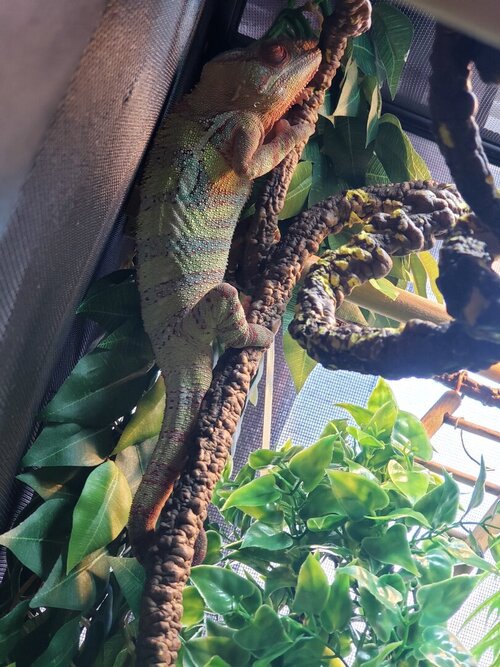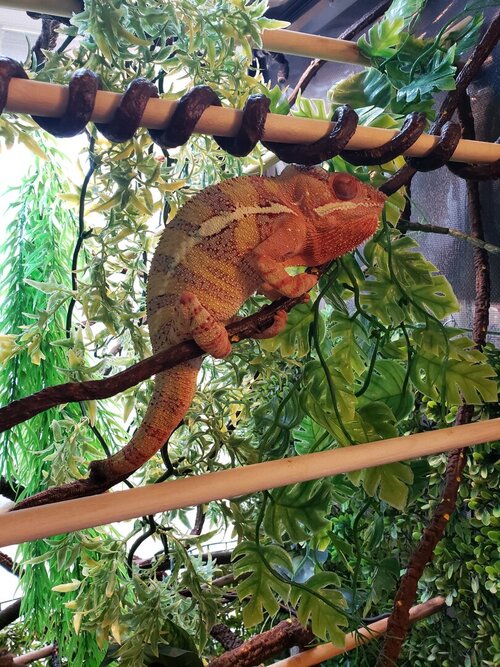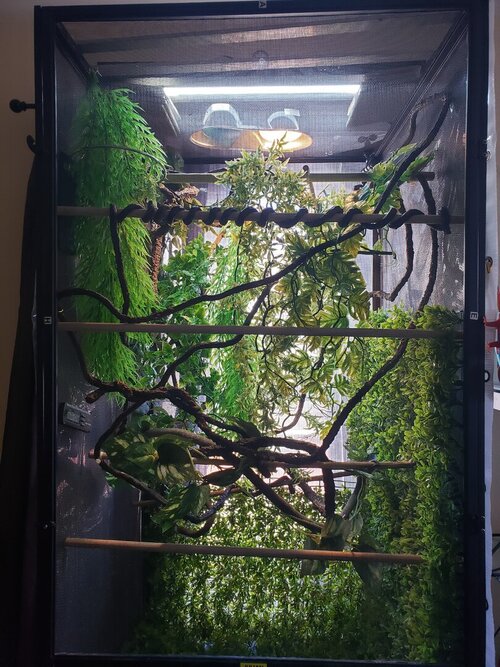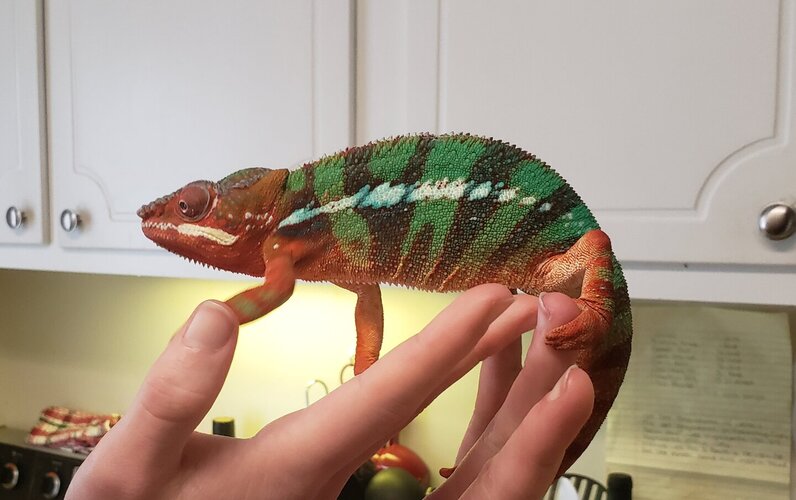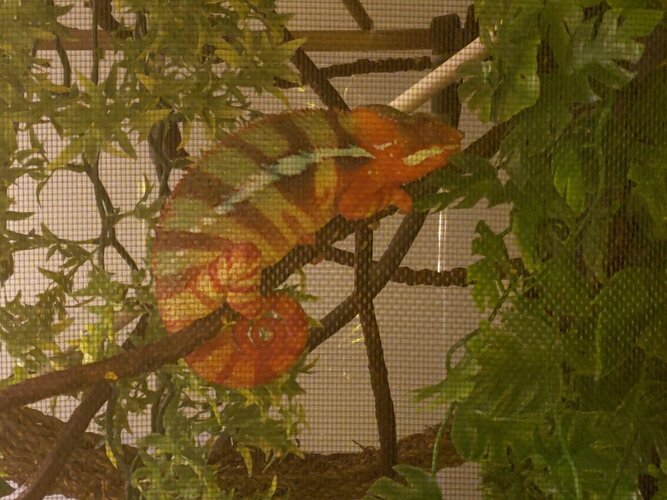JulianAndGuthixChams
New Member
I am at a loss with what to do with my panther chameleon Julian. I have taken him to 3 different exotic vets, the most recent being highly recommended by many people. His fecals were negative for parasites, his bloodwork came back fantastic according to the vet, no obvious signs of kidney issues or anything else. I really hope someone can help me because the only thing that has changed over the past couple of months is that I moved from an apartment to a house. Please see attached recent photos, older photos, enclosure photo, and bloodwork done on 1-11-21.
Your Chameleon - Panther Chameleon Julian. He is 2 years 3 months old. I've had him for about 9 months. I adopted him from my aunt because she did not have time for him. He was in her care for most of his life. Ever since I adopted him from my aunt, he struggled to wake up each day. For the longest time it would take him a few hours to wake up after his lights came on and he also struggled to go to bed at lights on. For a while in late 2020 he was doing amazing with waking up and going to sleep at the appropriate times. Now there are days where he will not move from his sleep spot at all. He will go 2 days without moving from the spot. Sometimes I will catch him with his left rear leg hanging while he sleeps. He also does not bask regularly and I know this is most likely having an effect on his digestion.
Handling - When I first got him he used to frantically want out of his enclosure, clawing at the screen. No longer frantic and only comes out on his own terms (usually not even once a week). Vet suggested light handling to promote exercise and strengthening of abdominal muscles.
Feeding - Receives a variety of insects including silkworms as a staple, and waxworms and hornworms as "treats". I feed him every other day if he has the energy. Does not eat from a bowl, is only hand fed because his vision does not seem great. He has been given vitamin A and D shots due to some tongue issues experienced previously. Hasn't had tongue issues in awhile, but his vision still does not seem great in his right eye.
Supplements - Repashy Calcium Plus LoD lightly used on all feedings, Repashy Vitamin A Plus w/ Calcium D3 & spirulina lightly once every other week.
Watering - Big dripper with tap water treated with ReptiSafe drops. Mist King setup to run twice a day for 2-3 mins, once in the morning and once in the evening. He used to drink a decent amount from the dripper, but he still seemed to always be slightly dehydrated. I have not seen him drink as much water as he used to because of his lack of energy.
Fecal Description - At the beginning of 2021 I took him to the vet because he was not moving from his sleeping spot each day and his color began to turn yellow which is a color that normally would only show while he slept. He also seemed constipated and had not gone for a few weeks. Blood work was done on 1/11/21 and was fantastic according to my vet and a second opinion. While at this visit Julian became very stressed and upset and made a large bowel movement and expressed himself/dropped sperm plugs. Poops looked normal before the visit when he was still going and were tested for parasites on 7/2/20 and 1/11/21, results negative for both. Urates are usually 'calcified' or hardened, a mix of both white and orange. He has made one bowel movement since 1/11/21 and that was on 3/6/21. The urates were white and overall soft, not calcified like previously, and his poop looked normal. No undigested food. All 3 vets that have seen him have not felt any enlargement of his kidneys.
History - His previous owner had him in a 16x16x30 screen enclosure with a large Chinese Evergreen (this plant was not moved into his new enclosure as it is not safe for him). The plant and vines in his old enclosure were so dense that he did not have anywhere to climb. He also was too close to his old basking lamp and must've developed a small burn on his back at some point while in her care. He also did not have a linear UVB bulb, he had a compact UVB bulb. His old enclosure was never cleaned. There were old poop/urates everywhere, as well as a couple of live dubias hiding in the plant.
He was fed crickets, dubias, and superworms that were only dusted with ReptiCalcium with D3. He was not provided calcium without D3 or a vitamin A supplement. He had a little dripper set up at the top of his enclosure with algae build up, and there was a fogger that was on constantly until it broke. No misting system. He was dehydrated before placed in my care and his tongue did not have any suction/stickiness.
His previous owner also had him outside of the cage fairly often and was surrounded by 3 loud dogs.
The first few days that he was in my care, he appeared very disoriented when it came time for his lights to shut off and he even fell while sleeping once. He did not sustain any injuries when he fell, but it did stun him.
Cage Info:
Cage Type - ReptiBreeze XL 24x24x48 w/ 3 walls covered with shower liner, with drainage holes in the floor into a basin
Lighting - 12 hours of linear T5 HO UVB & basking light BR30 65W flood light, with natural light from a window
Temperature - Ambient temperature 68°-72°, basking spot 78°-85°
Humidity - ~60-70% humidity after misting, ~30-40% otherwise
Plants - Fake plants up high. Bendable vines and dowel rods throughout the enclosure, rods secured through the screen with pins and glue. The right wall is covered with plastic plant panels so that my other chameleon is out of view. I have a large majesty palm plant to place in his enclosure but have not done so because I need to remove him to rearrange the enclosure to fit it.
Placement - Sitting on a card table by a window with natural light. His perch is about 2ft above my eye level.
Note: I also rescued a veiled chameleon from my aunt 5 months prior to rescuing Julian. He is thriving and I have only had to address minor issues with him, but from my understanding veiled chameleons can be a little hardier than panthers.
Your Chameleon - Panther Chameleon Julian. He is 2 years 3 months old. I've had him for about 9 months. I adopted him from my aunt because she did not have time for him. He was in her care for most of his life. Ever since I adopted him from my aunt, he struggled to wake up each day. For the longest time it would take him a few hours to wake up after his lights came on and he also struggled to go to bed at lights on. For a while in late 2020 he was doing amazing with waking up and going to sleep at the appropriate times. Now there are days where he will not move from his sleep spot at all. He will go 2 days without moving from the spot. Sometimes I will catch him with his left rear leg hanging while he sleeps. He also does not bask regularly and I know this is most likely having an effect on his digestion.
Handling - When I first got him he used to frantically want out of his enclosure, clawing at the screen. No longer frantic and only comes out on his own terms (usually not even once a week). Vet suggested light handling to promote exercise and strengthening of abdominal muscles.
Feeding - Receives a variety of insects including silkworms as a staple, and waxworms and hornworms as "treats". I feed him every other day if he has the energy. Does not eat from a bowl, is only hand fed because his vision does not seem great. He has been given vitamin A and D shots due to some tongue issues experienced previously. Hasn't had tongue issues in awhile, but his vision still does not seem great in his right eye.
Supplements - Repashy Calcium Plus LoD lightly used on all feedings, Repashy Vitamin A Plus w/ Calcium D3 & spirulina lightly once every other week.
Watering - Big dripper with tap water treated with ReptiSafe drops. Mist King setup to run twice a day for 2-3 mins, once in the morning and once in the evening. He used to drink a decent amount from the dripper, but he still seemed to always be slightly dehydrated. I have not seen him drink as much water as he used to because of his lack of energy.
Fecal Description - At the beginning of 2021 I took him to the vet because he was not moving from his sleeping spot each day and his color began to turn yellow which is a color that normally would only show while he slept. He also seemed constipated and had not gone for a few weeks. Blood work was done on 1/11/21 and was fantastic according to my vet and a second opinion. While at this visit Julian became very stressed and upset and made a large bowel movement and expressed himself/dropped sperm plugs. Poops looked normal before the visit when he was still going and were tested for parasites on 7/2/20 and 1/11/21, results negative for both. Urates are usually 'calcified' or hardened, a mix of both white and orange. He has made one bowel movement since 1/11/21 and that was on 3/6/21. The urates were white and overall soft, not calcified like previously, and his poop looked normal. No undigested food. All 3 vets that have seen him have not felt any enlargement of his kidneys.
History - His previous owner had him in a 16x16x30 screen enclosure with a large Chinese Evergreen (this plant was not moved into his new enclosure as it is not safe for him). The plant and vines in his old enclosure were so dense that he did not have anywhere to climb. He also was too close to his old basking lamp and must've developed a small burn on his back at some point while in her care. He also did not have a linear UVB bulb, he had a compact UVB bulb. His old enclosure was never cleaned. There were old poop/urates everywhere, as well as a couple of live dubias hiding in the plant.
He was fed crickets, dubias, and superworms that were only dusted with ReptiCalcium with D3. He was not provided calcium without D3 or a vitamin A supplement. He had a little dripper set up at the top of his enclosure with algae build up, and there was a fogger that was on constantly until it broke. No misting system. He was dehydrated before placed in my care and his tongue did not have any suction/stickiness.
His previous owner also had him outside of the cage fairly often and was surrounded by 3 loud dogs.
The first few days that he was in my care, he appeared very disoriented when it came time for his lights to shut off and he even fell while sleeping once. He did not sustain any injuries when he fell, but it did stun him.
Cage Info:
Cage Type - ReptiBreeze XL 24x24x48 w/ 3 walls covered with shower liner, with drainage holes in the floor into a basin
Lighting - 12 hours of linear T5 HO UVB & basking light BR30 65W flood light, with natural light from a window
Temperature - Ambient temperature 68°-72°, basking spot 78°-85°
Humidity - ~60-70% humidity after misting, ~30-40% otherwise
Plants - Fake plants up high. Bendable vines and dowel rods throughout the enclosure, rods secured through the screen with pins and glue. The right wall is covered with plastic plant panels so that my other chameleon is out of view. I have a large majesty palm plant to place in his enclosure but have not done so because I need to remove him to rearrange the enclosure to fit it.
Placement - Sitting on a card table by a window with natural light. His perch is about 2ft above my eye level.
Note: I also rescued a veiled chameleon from my aunt 5 months prior to rescuing Julian. He is thriving and I have only had to address minor issues with him, but from my understanding veiled chameleons can be a little hardier than panthers.

